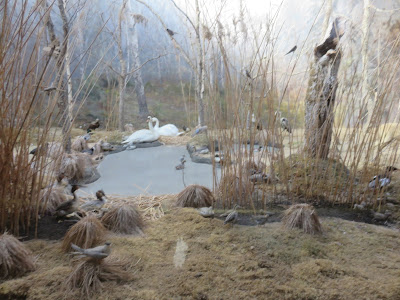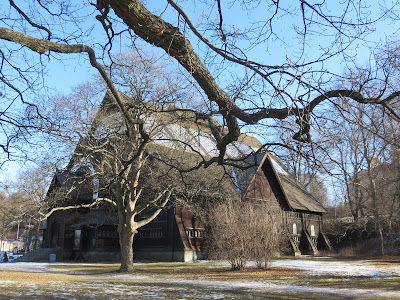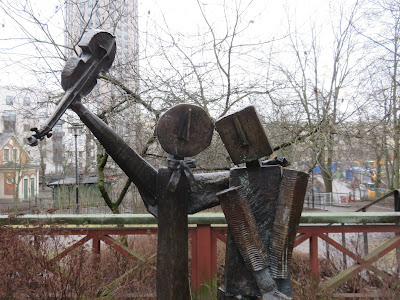Those last days were filled to the brim. There were a lot of "one last times" - one last fika, one last kardemumbulle, one last stroll through my favourite park, one last trip to that cute store with the equally cute shop assistant, one last nyponsoppa... There were also plenty of "I can't believe I still haven't dones" - visiting Stadshuset, Skovskyrkogården and even more museums, sampling more so far undiscovered pastries, having Swedish Easter (with branches decorated with coloured feathers and children dressed as even more colourful witches), eating a Swedish waffle, eating a what-the-Swedes-call-Belgian waffle... And, on top of all that, the inevitable freight train of ongoing thoughts, emotions and goodbyes had set itself in motion.
Many companies in Sweden, including Bonniers Konsthall, are closed on Maundy Thursday and Good Friday. So the Wednesday before that long weekend everyone gathered for a special fika in my honour. I was prepared to thank all my temporary colleagues for this incredible opportunity. I also knew in advance I was going to get a little surprise or gift. (I am sorry, Jåanna, Sara, Rebecka and Narek - suspicious meetings and hushed murmuring until one of you yells out "SHE UNDERSTANDS TOO MUCH SWEDISH. LET'S GO SOMEWHERE ELSE!" followed by all of you simultaneously going to the kitchen nowhere near lunchtime is not really a prime ninja strategy.) What I did not expect, was that I would be the one getting thanked for my time at Bonniers Konsthall. I was showered with uplifting and heart-warming compliments, both about my work and me as a person. I am not used to getting this kind of praise. The combination of Katya's wonderful little speech, everyone's kind words, the great gifts and the free cake made me feel like I was receiving a lifetime achievement award. It rendered me speechless.
At first I was afraid I would cry all throughout fika. There were indeed some tiny sobby moments, but overall I was just so happy and grateful to have one last fika with all these wonderful people. So I enjoyed every moment of it and I was able to go pack up with my mascara still intact. A few hours later, after finishing off the last tasks and clearing my desk, I closed the office door behind me and went up the bright red spiral staircase one last time. I stepped outside, into a warm ochre spring sunset. That's when the tears came. That was it. It was really over. Up until that moment, for almost a year, my Swedish internship had been the centre of my life: the application, the paperwork (so much paperwork), finding a place to do my internship, finding a place to live, planning, reading up, preparing, skype meetings, buying warm socks, shopping, packing… and then of course actually leaving for Stockholm and doing the internship. Even when I was occupied by other things, my Erasmus placement was always in the back of my head.
What now? I had no answer for that. So all the energy my brain had previously used on my internship now quickly got redirected into making up terrible doom scenarios. This was it, Cathy. Everything will go downhill from here on. You will return home and there will be nothing for you. You will never find a job that's even remotely as fun and interesting as this one. You will never ever have fika again. People in Belgium will not like you anymore and you will be alone, forever and ever... Forget about kardemumbullar and nyponsoppa. Forget about free coffee refills and gender equality. Forget about fresh air and efficient public transportation. And forget about white snow. From now on you are condemned to Belgium's toe biting ash grey slush and it will be the perfect metaphor for the drag of your daily life.
What now? I had no answer for that. So all the energy my brain had previously used on my internship now quickly got redirected into making up terrible doom scenarios. This was it, Cathy. Everything will go downhill from here on. You will return home and there will be nothing for you. You will never find a job that's even remotely as fun and interesting as this one. You will never ever have fika again. People in Belgium will not like you anymore and you will be alone, forever and ever... Forget about kardemumbullar and nyponsoppa. Forget about free coffee refills and gender equality. Forget about fresh air and efficient public transportation. And forget about white snow. From now on you are condemned to Belgium's toe biting ash grey slush and it will be the perfect metaphor for the drag of your daily life.
It took a sleepless, snot filled night and a lot of understanding nods and hugs from my patient friends to somewhat recompose myself. I managed to force the doom scenarios into a far off corner of my brain and I enjoyed every moment of my last week in Sweden. However, the sadness and fear were never absent. They slyly yet continuously nibbled on my thoughts, giving a sad undertone to everything I was doing. And that's ok. As Cecilia said during my farewell fika: "You're sad? Good. That means it was worth it." She was right, of course. It doesn't make saying goodbye easier, but it did help me accept all the bad emotions. They were, after all, testament of a fantastic time.
Feeling overwhelmed and lacking words at my farewell fika means that I never got to say a proper thank you to everyone. And even now, I know I can never find the words to express what this experience meant for me. But I want to give it a try anyway.
First off, a big thank you to all my ‘senior colleagues’ at PXL, especially Corry Hermans, Jochen Didden, Sarah Awouters and Lieve Cuypers, for all the support and encouragement. Maarten, Bert, Jef, Pascale, mom, and all my friends and family in Belgium: thank you for missing me while I was gone, it’s greatly appreciated. Bart, without you this adventure would not have been possible. Anton, my dear friend, your willingness to answer every question I have, no matter how ridiculous, should be honoured with an award. Kriss, you may have had your doubts about Sweden, but you never ever doubt me and for that I adore you. Nordin, my thanks for everything - always. And of course, to everyone at Bonniers Konsthall, I am forever in your debt for welcoming me, teaching me, supporting me, trusting me and inspiring me. Wiggle cats, Jåanna, Rebecka, Sara, Cecilia and Narek, you fantastic women and man at work, you were the best team ever. In fact, Marvel should make a superhero movie about us. And finally, Katya and Yuvinka, I could not have asked for better mentors. You made me feel at home from the first moment I arrived. You helped me, encouraged me, laughed with me, cried with me and believed in me. You both did everything to make sure I could make the most of my internship. But above all: I am proud and so grateful to have you both as friends. Thank you, thank you, thank you.
























![By Rekonstruktion efter Johan Holms tomtbok (Stockholms kartor/Stadsarkivet) [Public domain], via Wikimedia Commons](https://blogger.googleusercontent.com/img/b/R29vZ2xl/AVvXsEibfmGPEPAMFi14-hP0jXO2sw_O_VfcBF8mO3J0SuuEbF9lDPnvlJL3KP2WzGtmzGfJqEkV8yQnJxXDINVx6fh6jnOIlvIASgTJLwGXj3z3VnC2HExL_oGO4xD6KQc1fYsttaMUT-LhMvA/s400/Soedermalm_1674.jpg)






















